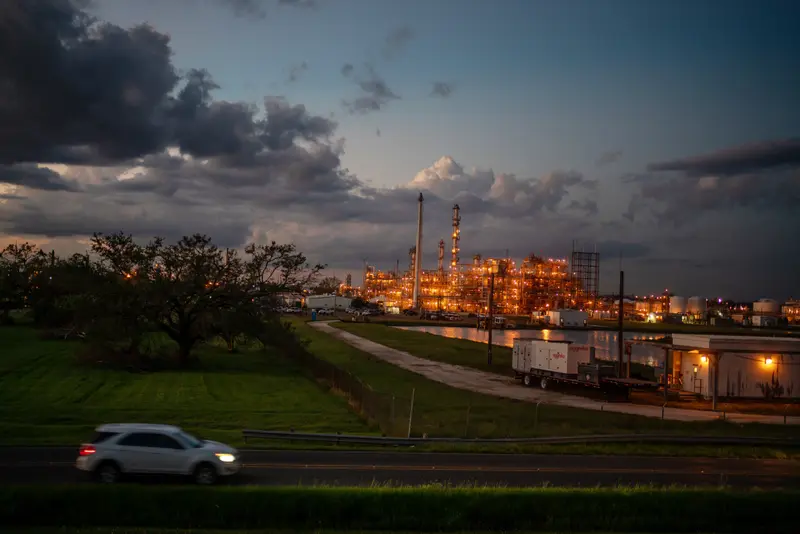The Environmental Protection Agency will drastically reduce cancerous air pollution from chemical plants. The regulation, announced last week, comes two years after a ProPublica analysis identified more than a thousand toxic hot spots that elevate the cancer risk of millions of Americans.
“This is an incredibly significant rule that will curtail some of the nation’s biggest drivers of cancer risk,” said Adam Kron, a senior attorney at Earthjustice, an environmental advocacy group.
The rule specifically targets ethylene oxide, a colorless gas, which is used to sterilize medical devices and has been labeled by the agency as “one of the most potent cancer-causing chemicals.” ProPublica’s analysis of emissions data found that between 2014 and 2018 ethylene oxide was the single biggest contributor to excess industrial cancer risk from air pollutants nationwide. The EPA expects that under the new regulation, annual emissions of ethylene oxide will fall by 80%. The rule also updates the standards for five other highly toxic chemicals: chloroprene, benzene, 1,3-butadiene, ethylene dichloride and vinyl chloride.
The hazards of such pollutants have not been borne equally. In predominantly Black census tracts, ProPublica found that the estimated cancer risk from toxic air pollution is more than double that of majority-white tracts. Many of the most dangerous chemical plants are in communities of color in Texas and Louisiana, along an 85-mile stretch of land that has come to be known as “Cancer Alley.”
In November 2021, three weeks after ProPublica published its analysis, the EPA administrator, Michael S. Regan, visited this heavily polluted corridor as part of his “Journey to Justice” tour. At elementary schools and churches, Regan vowed to local activists that he would use the tools at his disposal to rectify environmental inequities. Last week, at the signing ceremony at the EPA’s headquarters, Regan thanked leaders in these communities for continually holding “our feet to the fire.”
Nalleli Hidalgo, a community outreach liaison with Texas Environmental Justice Advocacy Services, attended the signing last week, after meeting with Regan on his listening tour. She told ProPublica she was overwhelmed by the people missing from the room who were not alive to witness this achievement. “We have lost too many loved ones as a result of bureaucratic inertia,” she said, noting that the EPA has long been required by law to update its risk standards for these chemicals. “Our communities should not have to wait one more day for fence line monitoring to take effect.”
For years, Texans like Hidalgo, living near chemical plants, have asked the agency to measure what they’re breathing in. ProPublica’s analysis found that for many homes closest to the fence lines of petrochemical plants in cities like La Porte and Port Neches, Texas, the estimated excess risk of cancer ranges from three to six times the level that the EPA considers acceptable. Our analysis, however, was based on the self-reported estimates from facilities, which can be unreliable and even underestimated. Without real-time monitoring data, it’s difficult for the agency to take action against polluters, even when residents point to unnerving patterns of headaches, asthma and cancers among their neighbors.
Under the new rule, hundreds of chemical plants will have to install monitoring for six hazardous chemicals at the fence line and share their data publicly online. When levels of these toxics exceed permitted amounts, facilities will be required to take corrective action to reduce them. The ExxonMobil plant in Baytown, Texas, just outside of Houston, for instance, is one of the largest refineries on the planet. It will now need to monitor for the carcinogen 1,3-butadiene, which its self-reported data shows it emits in large quantities. But, as Hidalgo noted, the EPA is still years behind updating its risk standards for other harmful air toxics, including ethylene, toluene and propylene. These chemicals are also emitted by the Baytown facility, according to its emissions data. (The facility did not respond to a request for comment.)
When the Biden administration introduced the rule last year, industry groups commented that curbing pollution would pose an undue and unnecessary burden. (The agency estimates that it will cost polluters roughly $1.8 billion to comply with the rules.) “I think people don’t appreciate how difficult it is to get a regulation of this magnitude promulgated,” said Scott Throwe, a former senior staffer in EPA’s Office of Enforcement and Compliance Assurance. “This is an industry that is very organized and has a great deal of impact on legislation and lobbying groups.” The American Chemistry Council said in a statement that the rule “will have significant implications on the production of key chemistries such as ethylene oxide” and that it remained “concerned with the recent onslaught of chemical regulations being put forth by this Administration.”
President Joe Biden has made environmental justice a centerpiece of his legislative agenda, but the legacy of some of his policies may depend on future presidents who do not share his priorities. The Trump administration, for instance, rolled back more than a hundred environmental protections, including two dozen air pollution and emissions policies. This current rule, however, will be hard to dismantle, experts say, because of the provision for continuous fence line monitoring. “If levels are being exceeded and there is no follow-up, the community will now have the actual data, and the opportunity to take their own action through citizen suits if they have not been sufficiently protected,” said Victor Flatt, an environmental law professor at Case Western Reserve University. “Even without much enforcement, the monitoring gives citizens a recourse.”
Throwe agreed. “The work that ProPublica did in identifying some of these disproportionately impacted communities helped draw attention to this issue,” he said. “We’ve seen the leverage these communities have when they have access to this information and can tell regulatory agencies that the levels they are exposed to are completely unacceptable.”
Lisa Song contributed reporting.












